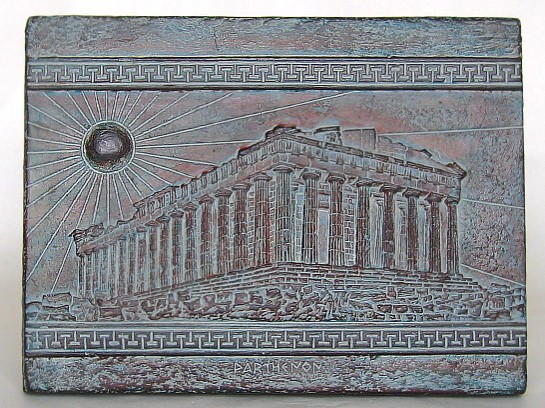The Parthenon is a temple of the Greek goddess Athena built in the 5th century BC on the Acropolis of Athens. It is the most important surviving building of Classical Greece, generally considered to be the culmination of the development of the Doric order.
Its decorative sculptures are considered one of the high points of Greek art. The Parthenon, one of the most visited archaeological sites in Greece today, is regarded as an enduring symbol of ancient Greece and of Athenian democracy, and is one of the world's greatest cultural monuments. The Greek Ministry of Culture is currently carrying out a program of restoration and reconstruction.
The Parthenon replaced an older temple of Athena, called the Pre-Parthenon or Older Parthenon, that was destroyed in the Persian invasion of 480 BC. Like most Greek temples, the Parthenon was used as a treasury, and for a time served as the treasury of the Delian League, which later became the Athenian Empire. In the 6th century AD, the Parthenon was converted into a Christian church dedicated to the Virgin. After the Ottoman conquest, it was converted into a mosque in the early 1460s. On September 28, 1687, an Ottoman ammunition dump inside the building was ignited by Venetian bombardment. The resulting explosion severely damaged the Parthenon and its sculptures.
In 1806, Thomas Bruce, 7th Earl of Elgin removed some of the surviving sculptures, with Ottoman permission. These sculptures, now known as the Elgin or Parthenon Marbles, were sold in 1816 to the British Museum in London, where they are now displayed. The Greek government is committed to the return of the sculptures to Greece, so far with no success.
The first endeavour to build a sanctuary for Athena Parthenos on the site of the present Parthenon was begun shortly after the battle of Marathon (c. 490-88 BC) upon a massive limestone foundation that extended and leveled the southern part of the Akropolis summit. This building replaced a hekatompedon (meaning "hundred-footer") and would have stood beside the archaic temple dedicated to Athena Polias. The Older or Pre-Parthenon, as it is frequently referred to, was still under construction when the Persians sacked the city in 480 BC and razed the Acropolis.
In the mid-5th century BC, when the Acropolis became the seat of the Delian League and Athens was the greatest cultural centre of its time, Pericles initiated an ambitious building project which lasted the entire second half of the fifth century BC. The most important buildings visible on the Acropolis today - that is, the Parthenon, the Propylaia, the Erechtheion and the temple of Athena Nike, were erected during this period.
Parthenon was built under the general supervision of the sculptor Phidias, who also had charge of the sculptural decoration. The architects, Iktinos and Kallikrates, began in 447 BC, and the building was substantially completed by 432, but work on the decorations continued until at least 431. Some of the financial accounts for the Parthenon survive and show that the largest single expense was transporting the stone from Mount Pentelicus, about 16 kilometers from Athens, to the Acropolis. The funds were partly drawn from the treasury of the Delian League, which was moved from the Panhellenic sanctuary at Delos to the Acropolis in 454 BC.
Although the nearby Temple of Hephaestus is the most complete surviving example of a Doric order temple, the Parthenon, in its day, was regarded as the finest. The temple, wrote John Julius Norwich, "Enjoys the reputation of being the most perfect Doric temple ever built. Even in antiquity, its architectural refinements were legendary, especially the subtle correspondence between the curvature of the stylobate, the taper of the naos walls and the entasis of the columns."
The stylobate is the platform on which the columns stand. It curves upwards slightly for optical reasons. Entasis refers to the slight tapering of the columns as they rise, to counter the optical effect of looking up at the temple. The effect of these subtle curves is to make the temple appear more symmetrical than it actually is.
Measured at the top step, the dimensions of the base of the Parthenon are 69.5 meters by 30.9 meters (228.0 x 101.4 ft). The cella was 29.8 metres long by 19.2 metres wide (97.8 x 63.0 ft), with internal Doric colonnades in two tiers, structurally necessary to support the roof. On the exterior, the Doric columns measure 1.9 meters (6.2 ft) in diameter and are 10.4 meters (34.1 ft) high. The corner columns are slightly larger in diameter. The Parthenon had 46 outer pillars and 19 inner pillars in total. The stylobate has an upward curvature towards its center of 60 millimeters (2.36 in) on the east and west ends, and of 110 millimeters (4.33 in) on the sides. Some of the dimensions form the golden rectangle expressing the golden ratio which is attributed to Pythagoras.
Product Details
Code: 01511
Dimensions: 18x24cm
Colors: White, Black, Brown
